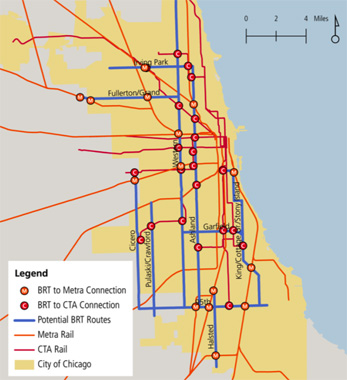With impressive urgency, Chicago Mayor Rahm Emanuel has spent his first months in office retooling and reconfiguring how the “City That Works” works. Emanuel’s energy is evident in changes from beat-cop deployment to the push for a longer school day, but perhaps the mayor’s most tangible efforts can be seen in his ambitious transportation agenda.

With Chicago DOT Commissioner Gabe Klein at his side, Emanuel has already implemented the city’s first protected bike lanes as part of a plan to add 100 miles of bike lanes within four years, announced a $1 billion upgrade to the Chicago Transit Authority’s Red Line, and passed a $2 “congestion fee” on downtown parking garages that will go towards the creation of a CTA Green Line stop that serves McCormick Place – the nation’s largest convention center – and a downtown circulator bus route being billed as bus rapid transit.
The circulator could be an interesting harbinger of Emanuel's bus policy and how far he will go with BRT. He has stated that BRT projects in Chicago will include “dedicated bus lanes, signal preemption, pre-paid boarding or on-board fare verification, multiple entry and exit points on the buses, limited stops, and at-grade boarding." As it’s proposed now -- with off-board fare payment and signal priority -- the downtown circulator is a step in this direction. But it has yet to be seen whether Chicago will commit to high-performance BRT that sets a precedent for other American cities.
From Boston to Kansas City, U.S. cities tend to implement "BRT-lite," where the actual benefits fall well short of expectations. Most of this disconnect is due to poor marketing by transit agencies trying to drum up excitement for projects that don't meet true BRT standards. When the projects deliver less than promised, the reputation of BRT as an effective transit solution suffers.
Chicago has a chance to change this perception and serve as a model for cities nationwide by building a "gold-standard" BRT system, based on the rating system established by the Institute for Transportation and Development Policy. Budgets may be tight, but as Emanuel is showing with his funding plan for the downtown circulator, he's not afraid to raise new revenues. And BRT's lower construction costs relative to rail may make it the most realistic way for Chicago to move ahead on expanding its transit network.
A blueprint for Chicago BRT already exists. In a report released this summer, “Bus Rapid Transit: Chicago’s New Route to Opportunity,” the Metropolitan Planning Council, a Chicago-based think tank, proposed a 10-route, 95-mile citywide system that aims to increase bus speed by twice the current average, establish connections between existing CTA and Metra commuter rail stations, and act as a catalyst for economic development. The recommendations call for BRT on streets with a minimum width of 86 feet, which would still allow for pedestrian-friendly sidewalks, bike lanes and car traffic. For routes where the BRT line would be placed in the median of the street, the MPC recommends a minimum street width of 97 feet.
The system envisioned by the MPC would employ off-board fare collection, separated rights of way, and platform-level boarding. Overall, it is projected to carry an additional 71,000 daily riders, and the MPC expects improved transit access along currently underserved routes like the South Side’s Garfield Boulevard to stimulate infill development.
A gold-standard BRT system in Chicago could serve as the bellwether for the next wave of American BRT. “Chicago looks very promising, and could be a model for other cities,” says ITDP Executive Director Walter Hook. “Rahm Emanuel understands BRT better than any other U.S. municipal leader, according to Enrique Penalosa,” he added, referring to the former mayor of Bogota, Colombia, who built perhaps the world’s most advanced BRT system. The early word from respected voices like Hook and Penalosa bodes well for Chicago’s BRT efforts. And if the city follows through, it will bode well for BRT nationwide.





